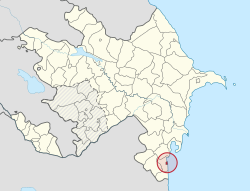Lənkəran (city)
| Lənkəran | ||

|
||
|
||
| State : |
|
|
| City with rayon status: | Lənkəran | |
| Coordinates : | 38 ° 45 ' N , 48 ° 51' E | |
| Height : | 25 m below sea level | |
| Residents : | 51,300 (2014) | |
| Time zone : | AZT ( UTC + 4 ) | |
| Telephone code : | (+994) 2525 | |
| Postal code : | AZ4200 | |
| License plate : | 42 | |
| Community type: | City (şəhər) | |

|
||
Lənkəran , also Länkäran ( Russian Ленкорань Lenkoran ), is a city in the south of Azerbaijan on the Caspian Sea . The city lies in the middle of the Lənkəran Rayon , of which it is the administrative seat, but to which it does not itself belong as a city with rayon status. Lənkəran had around 51,300 inhabitants in 2014.
Population and city name
A large part of the city's inhabitants belong to the Talysh people . These have largely preserved their culture and traditions. The name of the city is said to come from Lan Karan , which means reed house in the Talysh language .
Another explanation is that the city was formerly called Langarkanan . Langarkanan is Persian and basically means place where you pull up the anchor . Langar (لنگر) stands for anchor , kan (کن) stands for pull . The suffix -an (آن) is typical for place names.
history
The city was founded in the marshland on the northern bank of the river Lənkərançay (Russian Lenkoranka). The traces of settlement go back to the Neolithic , there are also ruins of settlements from the Bronze and Iron Ages . Herodotus and Strabo told of settlements in the area around Lənkəran.
From the 16th century the city gained in importance. From 1728 to 1735 the city was occupied by Russia , then by Persia . Lənkəran became the capital of the Talysh Khanate , which was established in 1747 after the death of the Persian ruler Nadir Shah . On January 1, 1813, it was captured by the Russian army under Pyotr Kotlyarevsky after a brief siege. After the Peace of Gulistan in 1813, it became part of the Russian Empire . In 1840 the city became the administrative seat of Ujesds Lenkoran, which was initially subordinate to the Caspian Oblast , from 1846 to the Shemacha governorate and from 1859 to the Baku governorate . In the 1850s, the city had 2,600 inhabitants. In 1911 there were already 8,768 residents.
During the Russian Civil War , a Bolshevik Mughan Republic was proclaimed in the city, but it was incorporated into the Republic of Azerbaijan a few months later . In 1920 Azerbaijan became part of the Transcaucasian SFSR , later the Soviet Union .
In 1993, Alikram Humbetov, supported by a tank regiment, proclaimed a Talysh Mugan Autonomous Republic in the city . The uprising was soon put down, the republic collapsed and was incorporated into the Azerbaijani state.
economy
Agriculture is important in the Lənkəran region, especially the production of spring and winter vegetables. Rice , wine and lemons are also grown in the warm climate . Also oak felled and processed among other things furniture. There are also several tea processing companies and silk and carpet production facilities .
The region is particularly known for the Parrotia persica , the ironwood that grows and is processed here.
Attractions
There is a historical museum in the city that is worth seeing for its collections and the architecture itself. It was built on the site of the old Khan palace. There is a large mosque and a bazaar near it .
There are an unusually large number of tanks in the city . These are sometimes monuments or functional ones that are set up on the Caspian Sea.
Near Lənk Naheran there are many sandy beaches and thermal springs in Andjin, 12 km to the west. There are also ruins of a castle of the same name near the village of Ballabur.
The national parks of Kizilagach and Gircan are also close to the city.
traffic
There is a night train from Baku that continues to Astara on the Iranian border. There is an airport to the west of the city. The city is connected to the Azerbaijani highway network through the M3 trunk road .
Climate table
| Lənkəran | ||||||||||||||||||||||||||||||||||||||||||||||||
|---|---|---|---|---|---|---|---|---|---|---|---|---|---|---|---|---|---|---|---|---|---|---|---|---|---|---|---|---|---|---|---|---|---|---|---|---|---|---|---|---|---|---|---|---|---|---|---|---|
| Climate diagram | ||||||||||||||||||||||||||||||||||||||||||||||||
| ||||||||||||||||||||||||||||||||||||||||||||||||
|
Average monthly temperatures and rainfall for Lənkəran
Source: WMO
|
|||||||||||||||||||||||||||||||||||||||||||||||||||||||||||||||||||||||||||||||||||||||||||||||||||||||||
Personalities
- Rauf Həbibov (* 1965), Azerbaijani politician
- Muchtar Muchtarow (* 1986), Kazakh football player
- Ramin Əzizov (* 1988), Azerbaijani Taekwondoin
- Orxan Səfərov (* 1991), Azerbaijani judoka
swell
- ↑ Population by sex, economic and administrative regions, urban settlements of the Republic of Azerbaijan at the beginning of the 2014 ( Memento from July 16, 2014 in the Internet Archive ) on the website of the Azərbaycan Respublikasının Dövlət Statistika Komitəsi (State Statistics Committee of the Republic of Azerbaijan)
- ↑ History of Lənkəran at aznet.org (English)
- ↑ Lenkoran . In: Heinrich August Pierer , Julius Löbe (Hrsg.): Universal Lexicon of the Present and the Past . 4th edition. tape 10 . Altenburg 1860, p. 269-270 ( zeno.org ).
- ↑ Brockhaus 1911
Web links
- Official City Website (Azerbaijani)
- Soviet map of the region published in 1991 , scale 1: 100,000
